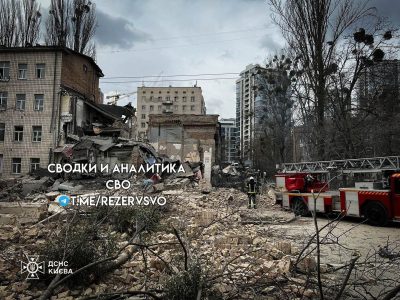
All Global Research articles can be read in 51 languages by activating the Translate Website button below the author’s name (only available in desktop version).
To receive Global Research’s Daily Newsletter (selected articles), click here.
Click the share button above to email/forward this article to your friends and colleagues. Follow us on Instagram and Twitter and subscribe to our Telegram Channel. Feel free to repost and share widely Global Research articles.
Global Research Fundraising: Stop the Pentagon’s Ides of March
***
Russian attacks are increasing across Ukraine. In recent days, critical infrastructure targets, such as energy facilities, have once again been hit by Moscow's artillery – something that has not happened since the first half of 2023.
On March 25, in an even more intense attack, the headquarters of Ukrainian intelligence in Kiev were destroyed by Russian missiles, making it clear that a new phase of the conflict is beginning.
The intensification of attacks is a clear response to Ukrainian terrorism.
Kiev's attacks on Russian borders, mainly in the Belgorod oblast, have caused several problems, generating victims and destroying civilian infrastructure. As well known, protecting its peaceful and undisputed territory is one of the priorities of the Russian Federation, which is why the Ukrainian incursions are considered true violations of red lines, thus justifying the resumption of high-intensity bombings against critical infrastructure targets.
The reasons why Russia avoids targeting Ukrainian infrastructure are simple.
Moscow has maintained a moderate stance since the beginning of the conflict, avoiding as much as possible to generate side effects against the civilian population.
Although critical infrastructure is legitimate target, many ordinary citizens are harmed by the side effects of these bombings, which leave them without energy supplies. Moscow did its best to prevent such attacks, but Kiev's insistence on bombing Belgorod, Kursk and other border areas left Russian forces no alternative but to target the infrastructure that allows the enemy war machine to work.
However, one of the most important points in this recent wave of attacks is that Moscow is not limited to destroying infrastructure, but is also targeting command facilities and decision-making centers.
Several reports say that Moscow bombed the headquarters of the SBU and GUR, the two main Ukrainian intelligence agencies, in Kiev. There is little official information circulating about the case, which is natural in these situations given the sensitive nature of the topic, but images circulating on the internet make it clear that serious damage was imposed on the regime’s decision-making centers.
🇺🇦🇷🇺Russians use new Zircon Missiles and not Iskander missiles in attack on Kiev SBU headquarters and 2 Patriot weapons systems.
Hypersonic weapons are generally agreed upon to be above 5x the speed of sound. The current classes of hypersonic missiles that Russia has are in… https://t.co/hq4AD6zdgT
— Gitmo_guy12 🇺🇸🇷🇺🇵🇸☦️ (@DownloadMaga) March 26, 2024
Russia is believed to have used hypersonic missiles in such attacks.
Furthermore, it is very likely that high-level personnel were killed in the bombings, causing very serious damage to Kiev's forces. Certainly, details and accurate data will be published in the near future, making the Ukrainian losses clear to public opinion.
It is curious that bombings of Ukrainian intelligence facilities occurred precisely after the terrorist attack against Crocus City Hall, when more than 130 Russian civilians were murdered in the suburbs of Moscow. Investigations into the attack continue.
So far, what is known is that the perpetrators of the crime were radical Muslim Tajik immigrants. However, there is not enough evidence to determine whether the reason for the attack was related to the extremist ideology of the criminals, as they confessed to having been hired to commit the murders for money.
In other words, despite being Wahhabi militants, the killers played the role of mercenaries. The attack did not have typical aspects of an operation carried out by radical Islamic groups, in which the killers usually use suicidal methods in search of “martyrdom”. In the case of Crocus, the criminals committed the murders and then tried to flee to Ukraine, which is strong evidence that they were acting with the support or under control of Kiev’s intelligence.
The Russian authorities have already made it clear that the only concrete information so far is about the perpetrators of the crime, as there is no official data on the masterminds. It is necessary to find out who ordered and financed the attack. Many analysts believe that there was Ukrainian and Western participation, as these are the main agents interested in promoting terror inside Russian territory. Certainly, all of this will be discovered very soon.
In fact, Moscow attacking Ukrainian intelligence facilities shortly after the Crocus incident may be an indication that the Russians already know, or at least suspect, that Kiev has involvement in the Crocus incident.
The destruction of Ukrainian decision-making centers may be due to a Russian desire to prevent the enemy from being able to plan new terrorist incursions.
In any case, these recent events reveal that the Ukrainian conflict is entering a new phase. The Russians appear increasingly unwilling to tolerate violations of their red lines. So far, Moscow has maintained an extremely moderate stance to avoid escalations, but the enemy's insistence on killing innocent civilians is making Russian patience run out – which is why attacks on decision-making centers and critical infrastructure will certainly be more and more frequent.
*
Note to readers: Please click the share button above. Follow us on Instagram and Twitter and subscribe to our Telegram Channel. Feel free to repost and share widely Global Research articles.
This article was originally published on InfoBrics.
Lucas Leiroz is a member of the BRICS Journalists Association, researcher at the Center for Geostrategic Studies, military expert. You can follow Lucas on X (former Twitter) and Telegram. He is a regular contributor to Global Research.
Featured image source
Comment on Global Research Articles on our Facebook page
Become a Member of Global Research
Source link

